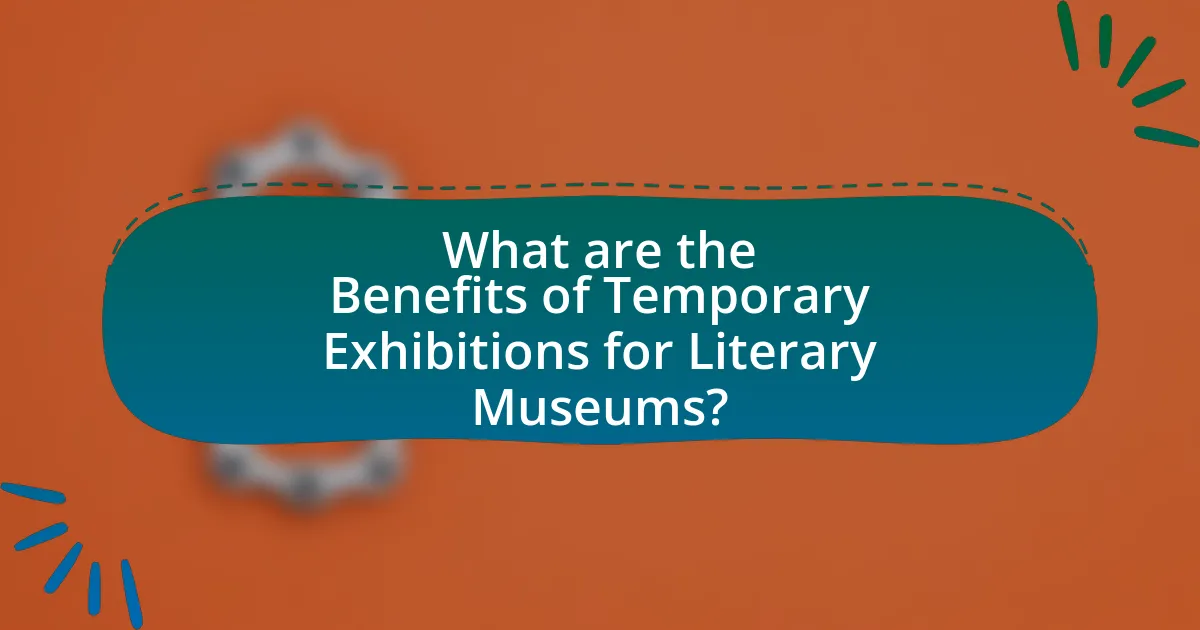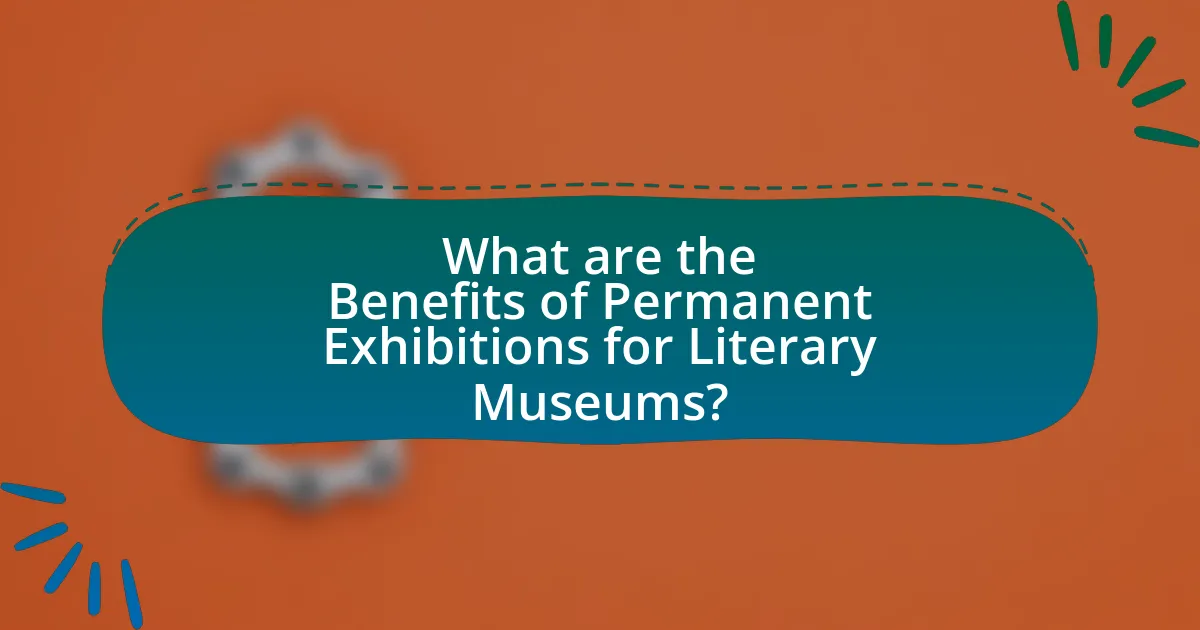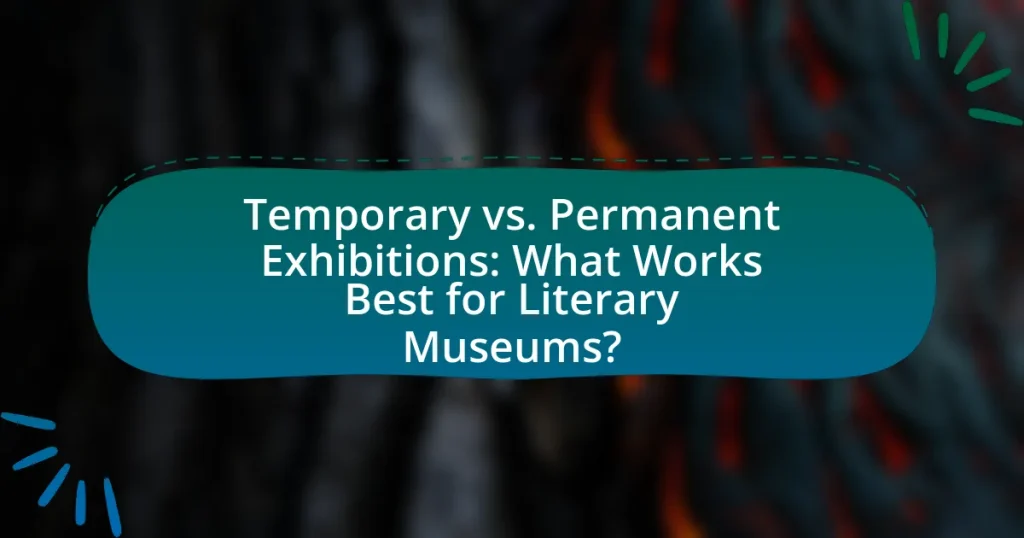The article examines the distinctions between temporary and permanent exhibitions in literary museums, highlighting their unique characteristics, benefits, and challenges. Temporary exhibitions are dynamic, changing regularly to engage visitors with fresh content and contemporary themes, while permanent exhibitions provide a stable foundation showcasing significant literary works and authors. The discussion includes factors influencing the choice between the two types, strategies for audience engagement, and the financial implications associated with hosting exhibitions. Ultimately, the article aims to clarify how literary museums can effectively balance innovation with tradition in their exhibition programming.

What are Temporary and Permanent Exhibitions in Literary Museums?
Temporary exhibitions in literary museums are curated displays that change periodically, often focusing on specific themes, authors, or literary movements, allowing for fresh content and engagement with current literary discussions. In contrast, permanent exhibitions are long-term installations that showcase the museum’s core collection, highlighting significant authors, their works, and the historical context of literature, providing a stable foundation for visitors’ understanding of literary heritage. This distinction is crucial as it allows literary museums to balance the dynamism of contemporary literary discourse with the preservation of literary history.
How do Temporary Exhibitions differ from Permanent Exhibitions?
Temporary exhibitions differ from permanent exhibitions primarily in their duration and content. Temporary exhibitions are designed to be displayed for a limited time, often featuring specific themes, artists, or collections that change regularly, while permanent exhibitions are intended to remain on display indefinitely, showcasing a museum’s core collection or ongoing themes. For instance, a literary museum may host a temporary exhibition on a specific author or literary movement for a few months, whereas its permanent exhibition would include foundational works and artifacts that represent the museum’s overall mission and history. This distinction allows temporary exhibitions to attract repeat visitors with fresh content, while permanent exhibitions provide a stable educational resource.
What are the defining characteristics of Temporary Exhibitions?
Temporary exhibitions are characterized by their limited duration, often lasting from a few weeks to several months, which distinguishes them from permanent exhibitions. These exhibitions frequently showcase specific themes, artists, or collections that are not part of the museum’s permanent holdings, allowing for a dynamic and changing visitor experience. Additionally, temporary exhibitions often incorporate innovative display techniques and interactive elements to engage audiences, reflecting current trends or significant cultural events. The flexibility in content and presentation enables museums to attract diverse audiences and respond to contemporary issues, making temporary exhibitions a vital aspect of cultural programming.
What are the defining characteristics of Permanent Exhibitions?
Permanent exhibitions are characterized by their long-term display of artifacts and information, designed to provide a consistent educational experience. These exhibitions typically feature a cohesive theme or narrative that remains unchanged over time, allowing visitors to engage with the material at their own pace. Unlike temporary exhibitions, permanent exhibitions are often curated to reflect the core mission of the institution, showcasing significant collections that represent the history, culture, or achievements relevant to the subject matter. For instance, a literary museum may maintain a permanent exhibition dedicated to the works of a specific author, ensuring that key texts and related artifacts are always accessible to the public. This stability fosters ongoing learning and appreciation, as visitors can return to the exhibition multiple times to deepen their understanding.
Why do Literary Museums choose one type over the other?
Literary museums choose one type of exhibition over the other based on their goals for audience engagement and resource availability. Temporary exhibitions often attract visitors with fresh content and can be tailored to current literary trends or events, while permanent exhibitions provide a stable, ongoing narrative that reflects the museum’s core mission and collection. For instance, the British Library frequently updates its temporary exhibitions to align with contemporary themes, thereby increasing visitor numbers, while the permanent collection offers a comprehensive view of literary history. This strategic choice allows museums to balance innovation with tradition, ensuring they remain relevant and educational.
What factors influence the decision for Temporary Exhibitions?
The decision for temporary exhibitions is influenced by factors such as audience engagement, thematic relevance, budget constraints, and logistical considerations. Audience engagement drives the selection of topics that resonate with current interests, ensuring higher visitor turnout. Thematic relevance ensures that the exhibition aligns with the museum’s mission and current literary trends, enhancing its educational value. Budget constraints dictate the feasibility of exhibition design, marketing, and operational costs, while logistical considerations involve the availability of space and resources for installation and maintenance. These factors collectively shape the strategic planning and execution of temporary exhibitions in literary museums.
What factors influence the decision for Permanent Exhibitions?
The decision for Permanent Exhibitions is influenced by factors such as audience engagement, educational value, funding availability, and the significance of the collection. Audience engagement is crucial as museums aim to attract and retain visitors; studies show that exhibitions that resonate with the public lead to higher attendance rates. Educational value is another key factor, as permanent exhibitions often serve to inform and educate the public about specific themes or historical contexts, enhancing the museum’s mission. Funding availability directly impacts the feasibility of creating and maintaining permanent exhibitions; financial support from grants, donations, or sponsorships is essential for long-term projects. Lastly, the significance of the collection, including its uniqueness and relevance to cultural heritage, plays a vital role in determining whether an exhibition will be permanent, as institutions prioritize showcasing items that contribute meaningfully to their narrative and mission.

What are the Benefits of Temporary Exhibitions for Literary Museums?
Temporary exhibitions provide literary museums with increased visitor engagement, enhanced educational opportunities, and the ability to showcase diverse themes and authors. By frequently changing exhibits, museums can attract repeat visitors who are interested in new content, thereby boosting attendance numbers. For instance, a study by the American Alliance of Museums found that temporary exhibitions can increase visitor numbers by up to 30% compared to static displays. Additionally, these exhibitions allow museums to collaborate with contemporary authors and institutions, fostering community connections and promoting literary culture. This adaptability not only enriches the visitor experience but also supports the museum’s mission to educate and inspire through literature.
How do Temporary Exhibitions attract different audiences?
Temporary exhibitions attract different audiences by offering unique, time-limited experiences that create a sense of urgency and novelty. These exhibitions often feature diverse themes, artists, or topics that appeal to various demographic groups, such as families, students, or art enthusiasts. For instance, a temporary exhibition on contemporary literature may draw younger audiences interested in current trends, while a historical exhibition could attract older visitors with a focus on literary heritage. Additionally, marketing strategies, such as targeted social media campaigns and community engagement events, enhance visibility and accessibility, further diversifying the audience. Research indicates that 70% of visitors to temporary exhibitions are motivated by the desire to see something new, highlighting their effectiveness in attracting varied groups.
What strategies can be used to engage visitors with Temporary Exhibitions?
To engage visitors with Temporary Exhibitions, museums can implement interactive elements, such as hands-on activities and digital experiences. These strategies enhance visitor participation and create memorable experiences. For instance, incorporating augmented reality features allows visitors to interact with exhibits in innovative ways, increasing their engagement. Research indicates that interactive exhibits can boost visitor satisfaction and retention rates, as seen in studies conducted by the American Alliance of Museums, which found that 70% of visitors prefer interactive experiences over passive viewing. Additionally, hosting special events, such as artist talks or workshops related to the exhibition theme, can further attract and engage audiences, fostering a deeper connection with the content.
How do Temporary Exhibitions enhance the museum’s reputation?
Temporary exhibitions enhance a museum’s reputation by attracting diverse audiences and showcasing innovative themes. These exhibitions often feature unique collections or contemporary artists, which can generate media attention and public interest. For instance, a temporary exhibition that includes rare manuscripts or interactive installations can draw visitors who may not typically engage with the museum, thereby increasing foot traffic and visibility. Additionally, successful temporary exhibitions can lead to positive reviews and word-of-mouth recommendations, further solidifying the museum’s standing in the cultural community.
What challenges do Temporary Exhibitions present?
Temporary exhibitions present several challenges, including limited time for planning and execution, logistical complexities, and audience engagement issues. The short duration often restricts the amount of time available for curatorial research, which can lead to rushed decisions and potentially lower quality displays. Logistically, the need to transport, install, and dismantle exhibits within a tight timeframe can strain resources and increase costs. Additionally, attracting and retaining audience interest can be difficult, as temporary exhibitions may not have the same established draw as permanent collections, leading to fluctuating visitor numbers. These challenges necessitate careful planning and resource allocation to ensure successful outcomes.
How can museums overcome logistical challenges with Temporary Exhibitions?
Museums can overcome logistical challenges with Temporary Exhibitions by implementing advanced planning and collaboration strategies. Effective project management techniques, such as creating detailed timelines and checklists, help ensure that all aspects of the exhibition are addressed in a timely manner. Collaboration with local vendors and suppliers can streamline the procurement of necessary materials and services, reducing delays. Additionally, utilizing technology for inventory management and exhibition design can enhance efficiency. For instance, the American Alliance of Museums emphasizes the importance of early stakeholder engagement and clear communication to mitigate potential issues, which has been shown to improve the overall success of temporary exhibitions.
What are the financial implications of hosting Temporary Exhibitions?
Hosting temporary exhibitions can lead to significant financial implications, including both potential revenue generation and costs. Revenue can be generated through ticket sales, increased visitor numbers, and merchandise sales, which can enhance overall museum income. For instance, a study by the American Alliance of Museums found that temporary exhibitions can increase attendance by up to 30%, directly impacting ticket sales. However, costs associated with hosting these exhibitions include installation expenses, insurance, marketing, and transportation of exhibits, which can be substantial. According to the National Endowment for the Arts, the average cost of a temporary exhibition can range from $50,000 to $200,000, depending on the scale and complexity. Therefore, while temporary exhibitions can boost revenue, they also require careful financial planning to manage associated costs effectively.

What are the Benefits of Permanent Exhibitions for Literary Museums?
Permanent exhibitions for literary museums provide a stable platform for showcasing significant literary works and authors, enhancing visitor engagement and education. These exhibitions allow museums to create a consistent narrative around literary history, making it easier for visitors to understand the context and impact of various works. Furthermore, permanent exhibitions can attract repeat visitors, as they offer a reliable experience that encourages deeper exploration of the literary themes presented. Research indicates that museums with permanent exhibitions often see increased attendance and community involvement, as they serve as cultural landmarks that foster a sense of identity and pride within the community.
How do Permanent Exhibitions contribute to a museum’s identity?
Permanent exhibitions contribute significantly to a museum’s identity by providing a stable and consistent representation of its core themes and values. These exhibitions often showcase the museum’s primary collections, reflecting its mission and the cultural narratives it aims to convey. For instance, the British Museum’s permanent collection of ancient artifacts establishes its identity as a global center for historical and cultural education. By offering visitors a lasting experience that encapsulates the museum’s focus, permanent exhibitions help to solidify its reputation and foster a sense of belonging among its audience.
What role do Permanent Exhibitions play in educational outreach?
Permanent exhibitions serve as foundational tools for educational outreach by providing consistent access to curated knowledge and cultural artifacts. They facilitate ongoing learning opportunities for diverse audiences, including students, educators, and the general public. Research indicates that permanent exhibitions enhance visitor engagement and retention of information, as they allow for repeated visits and deeper exploration of themes over time. For instance, studies have shown that institutions with well-designed permanent exhibitions report higher visitor satisfaction and educational impact compared to those relying solely on temporary displays. This underscores the importance of permanent exhibitions in fostering a sustained educational dialogue within literary museums.
How do Permanent Exhibitions foster long-term visitor engagement?
Permanent exhibitions foster long-term visitor engagement by providing a stable and consistent experience that encourages repeat visits. These exhibitions often feature in-depth narratives and comprehensive collections that allow visitors to form a deeper connection with the subject matter over time. Research indicates that museums with permanent exhibitions see higher visitor retention rates, as they create a sense of familiarity and ongoing discovery. For instance, a study by the American Alliance of Museums found that 70% of visitors return to museums with permanent collections, as they can explore new aspects of the exhibits during each visit. This sustained engagement is further enhanced by educational programs and events that complement the permanent displays, fostering a community of returning visitors who develop a lasting relationship with the museum.
What challenges do Permanent Exhibitions face?
Permanent exhibitions face several challenges, including maintaining visitor engagement, adapting to changing audience expectations, and ensuring the preservation of artifacts. Visitor engagement can decline over time as audiences may find the content repetitive or unchanging, leading to decreased attendance. Adapting to changing audience expectations is crucial, as modern visitors often seek interactive and immersive experiences, which may not align with traditional exhibition formats. Additionally, the preservation of artifacts poses a challenge, as environmental factors and wear over time can threaten the integrity of displayed items, necessitating ongoing conservation efforts. These challenges highlight the need for continuous innovation and adaptation in the design and management of permanent exhibitions.
How can museums maintain and update Permanent Exhibitions effectively?
Museums can maintain and update permanent exhibitions effectively by implementing regular reviews and incorporating visitor feedback. Regular assessments allow museums to identify outdated information or exhibits that require enhancement, ensuring that the content remains relevant and engaging. For instance, the American Museum of Natural History conducts periodic evaluations of its exhibitions, which helps in making necessary updates based on new research and visitor interests. Additionally, integrating technology, such as interactive displays or augmented reality, can enhance the visitor experience and keep the exhibitions dynamic. This approach not only attracts repeat visitors but also aligns with contemporary educational practices, as seen in institutions like the British Museum, which frequently updates its permanent collections to reflect current scholarship and public interest.
What are the costs associated with establishing Permanent Exhibitions?
The costs associated with establishing permanent exhibitions typically include construction and installation expenses, exhibit design and fabrication, ongoing maintenance, and staffing. Construction and installation costs can range from tens of thousands to millions of dollars, depending on the size and complexity of the exhibition space. Exhibit design and fabrication often require specialized professionals, which adds to the overall budget. Ongoing maintenance costs, including repairs and updates, are necessary to keep the exhibition relevant and functional. Staffing costs encompass salaries for curators, educators, and support staff needed to manage the exhibition. According to the American Alliance of Museums, the average cost for a permanent exhibition can exceed $1 million, highlighting the significant financial investment required for such projects.
How can Literary Museums decide between Temporary and Permanent Exhibitions?
Literary museums can decide between temporary and permanent exhibitions by evaluating their objectives, audience engagement, and resource availability. Temporary exhibitions allow museums to showcase specific themes or authors for a limited time, attracting repeat visitors and generating excitement. In contrast, permanent exhibitions provide a stable foundation that reflects the museum’s core mission and collections. For instance, the British Library’s permanent exhibition on the history of the written word serves as a constant educational resource, while its temporary exhibitions on contemporary authors draw in diverse audiences. Ultimately, the decision hinges on balancing the need for dynamic programming with the commitment to long-term educational goals.
What best practices should be considered when planning exhibitions?
When planning exhibitions, best practices include defining clear objectives, understanding the target audience, and ensuring effective layout and design. Clear objectives guide the exhibition’s theme and content, while knowledge of the target audience helps tailor the experience to their interests and needs. Effective layout and design enhance visitor engagement and facilitate the flow of traffic through the exhibition space. Additionally, incorporating interactive elements can increase visitor participation, as studies show that interactive exhibits can boost retention of information by up to 60%. Budget management is also crucial, as it ensures that resources are allocated efficiently to meet the exhibition’s goals.


